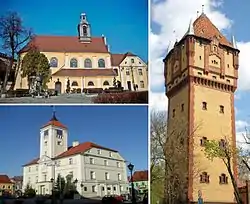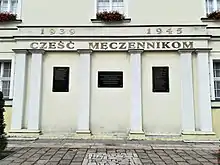Kościan
Kościan [ˈkɔɕt͡ɕan] (German: Kosten) is a town on the Obra canal in west-central Poland, with a population of 23,952 inhabitants as of June 2014.[1] Situated in the Greater Poland Voivodeship (since 1999), previously in Leszno Voivodeship (1975–1998), it is the capital of Kościan County.
Kościan | |
|---|---|
 Christ Church, Town Hall and Water Tower | |
 Flag  Coat of arms | |
 Kościan | |
| Coordinates: 52°5′N 16°39′E | |
| Country | |
| Voivodeship | Greater Poland |
| County | Kościan |
| Gmina | Kościan (urban gmina) |
| Established | 12th century |
| Town rights | 13th century |
| Government | |
| • Mayor | Piotr Ruszkiewicz |
| Area | |
| • Total | 8.75 km2 (3.38 sq mi) |
| Highest elevation | 85 m (279 ft) |
| Lowest elevation | 75 m (246 ft) |
| Population (2014) | |
| • Total | 23,952 |
| • Density | 2,700/km2 (7,100/sq mi) |
| Time zone | UTC+1 (CET) |
| • Summer (DST) | UTC+2 (CEST) |
| Postal code | 64-000 |
| Area code | +48 65 |
| Car plates | PKS |
| Website | http://www.koscian.pl |


History
Kościan was founded in the 12th or 13th century, when it was part of the Duchy of Greater Poland of the fragmented Polish realm.[2][3] It was granted town rights in the second half of the 13th century, which were later confirmed by King Władysław Jagiełło in 1400.[2] From 1332 Kościan was a royal town of Poland.[2] It was a county (powiat) seat[2] in the Poznań Voivodeship in the Greater Poland Province of the Polish Crown. In the 15th century Kościan was famous for its cloth production.[2][3] King Casimir IV Jagiellon granted Kościan cloths the first industrial trademark in the history of Poland.[2] At the time Kościan was the second largest city within historic Greater Poland (behind Poznań).[2][3]
Kościan was captured by the Swedes during the Swedish invasion of Poland (the Swedish Deluge) in 1655, but was soon recaptured by a partisan unit led by Krzysztof Żegocki.[3] The town suffered from further Swedish and Russian invasions in the 18th century,[3] and was annexed by Prussia in the Second Partition of Poland in 1793.[2] The Polish Greater Poland uprising of 1794 began in Kościan.[4] In 1807 the town became part of the short-lived Polish Duchy of Warsaw, before being reannexed by Prussia in 1815, and it was restored to Poland after the country regained independence in 1918. During the German occupation of Poland (World War II), the Polish population was subject to mass arrests, executions, expulsions, deportations to Nazi concentration camps and confiscation of property.[2] The Einsatzgruppe VI carried out public executions of Poles in the town on October 2 and October 23, 1939 as part of the Intelligenzaktion, killing 8 and 18 people respectively, including activists, merchants, landowners, the director of the local narrow gauge railway, the chairman of the local branch of the "Sokół" Polish Gymnastic Society, principals of schools from Kościan and the nearby village of Borowo and one student.[5] In Kościan, the Germans operated a prison for Poles from both the town and the region, many of whom were later transported to the infamous Fort VII in Poznań.[6] On November 7 and 9, 1939, 66 Polish craftsmen, merchants, farmers, local officials and workers, previously held in the local prison were massacred in the nearby forest.[7] Further such massacres were carried out by the Germans in December 1939 and in January and February 1940.[8] The local high school principal was among Polish teachers and principals murdered in the Dachau concentration camp.[9] Over 50 Poles, including local activists, intelligentsia and the families of victims of executions, were expelled in 1939, while 2,139 Poles were expelled in 1940, and their houses were then handed over to German colonists as part of the Lebensraum policy.[10] 534 patients of the local psychiatric hospital were gassed by the Germans in January 1940, and afterwards patients from psychiatric hospitals in Germany were transported to Kościan and also gassed.[11]
Sports
The local football club is Obra Kościan. It competes in the lower leagues.
Notable people
- Dezydery Chłapowski (1788–1879), general and political activist
- Klemens Koehler (1840–1901), physician
- Józef Surzyński (1851–1919), composer
- Feliks Stamm (1901–1976), boxing coach
- Izabella Zielińska (1910–2017), pianist
- Rafał Bryndal (born 1960), satirist and journalist
- Jarosław Jaromi Drażewski (born 1961), musician
- Waldemar Brygier (born 1970), journalist
- Bartosz Jurecki (born 1979), handball player
- Michał Jurecki (born 1984), handball player
- Krystian Klecha (born 1984), speedway rider
- Adam Szłapka (born 1984), politician
- Tomasz Nowak (born 1985), footballer
- Zofia Nowakowska (born 1988), singer
International relations
Twin towns – Sister cities
Kościan is twinned with:
|
|
Gallery
 Town hall, which currently houses the Regional Museum
Town hall, which currently houses the Regional Museum Christ Church built in 1666
Christ Church built in 1666.jpg.webp) Kościański Canal
Kościański Canal District court and Pope John Paul II Monument
District court and Pope John Paul II Monument Florian Marciniak Monument
Florian Marciniak Monument Municipal park
Municipal park
References
- Główny Urząd Statystyczny: Ludność. Stan i struktura w przekroju terytorialnym (2009) Archived 2010-02-15 at the Wayback Machine
- "Historia Kościana". Koscian.pl (in Polish). Retrieved 9 August 2020.
- Leon Plater, Opisanie historyczno-statystyczne Wielkiego Księztwa Poznańskiego, Księgarnia Zagraniczna, Lipsk, 1846, p. 207 (in Polish)
- Plater, p. 207-208
- Maria Wardzyńska, Był rok 1939. Operacja niemieckiej policji bezpieczeństwa w Polsce. Intelligenzaktion, IPN, Warszawa, 2009, p. 193, 198 (in Polish)
- Maria Wardzyńska, Był rok 1939. Operacja niemieckiej policji bezpieczeństwa w Polsce. Intelligenzaktion, p. 117, 190
- Maria Wardzyńska, Był rok 1939. Operacja niemieckiej policji bezpieczeństwa w Polsce. Intelligenzaktion, p. 200-201
- Maria Wardzyńska, Był rok 1939. Operacja niemieckiej policji bezpieczeństwa w Polsce. Intelligenzaktion, p. 201
- Maria Wardzyńska, Był rok 1939. Operacja niemieckiej policji bezpieczeństwa w Polsce. Intelligenzaktion, p. 216
- Maria Wardzyńska, Wysiedlenia ludności polskiej z okupowanych ziem polskich włączonych do III Rzeszy w latach 1939-1945, IPN, Warszawa, 2017, p. 156, 198 (in Polish)
- Maria Wardzyńska, Był rok 1939. Operacja niemieckiej policji bezpieczeństwa w Polsce. Intelligenzaktion, p. 217

